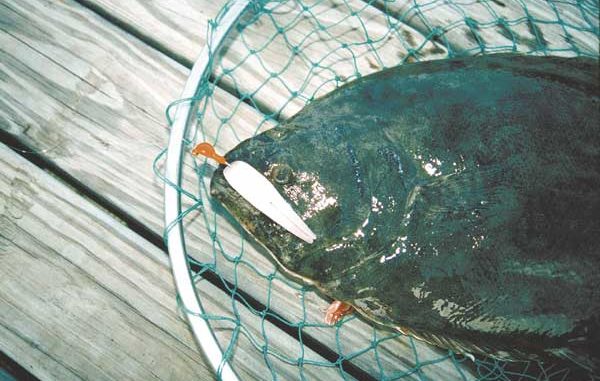
The tactics of a Kure Beach Pier angler are legendary when it comes to consistently catching big flounder.
Alone, lean fisherman walked the planks of Kure Beach Fishing Pier, nodding his head and speaking as he approached others who had taken up stationary positions with their rods leaning against the rails. One by one, he spoke to them as he approached the anglers. A stranger no more, he asked them whether any fish were biting. Sharing pleasantries and fishing stories, each angler in turn lifted their rod allow him to pass along without lifting his line from the water.
Haywood “Popeye” McIntyre continued talking and walking — while he dragged a live mullet along the bottom, concentrating on the sensations of sand scrubbing along beneath his sinker. As his baitfish passed each pier piling, he paused for several minutes, trying to detect a strike.
Next to one of the pilings, a fish sucked in the baitfish and the rod tip twitched. McIntyre let the line go slack for a few moments, then he set the hook — hard.
“I need a net,” he said. “I’ve got one on!”
Springing to action, one of the other pier fishermen dropped a hoop net to the water, as McIntyre led the fish above the net. Surrounded by mesh and sky-lifted, a big flounder was soon flapping against the wooden pier deck, making as much noise as a kid running the planks with wet flip-flops.
“Fishing from piers is all I’ve ever done,” McIntyre said. “Mostly what I fish for at the piers is flounder. I like to catch them because they are the best-eating fish I know of.”
McIntyre, walking the planks of Kure Beach Fishing Pier, said he enjoyed fishing at that particular pier the most.
“They’re the nicest people that fish there,” he said. “If you’re polite, they’ll let you work your bait right on by them. They know you’re fishing for flounder, and it doesn’t have any effect on their fishing.”
McIntyre said he got the nickname “Popeye” from his father. His father always called him by the cartoon character’s name.
“It’s been my nickname ever since I was born,” he said. “My daddy always called me that because he used to like Popeye comic books.”
But McIntyre’s appearance mimics the cartoon character in subtle ways. There’s a sailor’s tan from years in the sun’s reflected rays off the ocean, the lanky and hardy stature that belies his 74 years of age, and the morality of his character. He does good deeds, especially taking others fishing when he gets the chance.
McIntyre had given Johnny Bailey of Wilmington a ride to the pier. Bailey’s parents don’t fish much and the youngster is several years shy of being old enough to drive, so McIntyre had taken the time to pick him up at his home.
“I met him at the pier one day, and now we’re friends,” Bailey said. “Fishing is the most fun I can think of. I’d fish every day if I could. I like to fish for kings, and I like to fish for flounder, too. I like fishing for anything that bites.”
Now retired, McIntyre was in the nightclub business in Fayetteville, where he operated a club named “Popeye’s”. He also worked for the Fayetteville Community Recreation Center for 15 years.
“Johnny’s uncle, Ben Bailey, fishes at the pier and brings Johnny when he can,” he said. “It’s a joy to take children fishing
“I’d rather be around children than around grown people. They appreciate anything you do for them.”
McIntyre is a living pier legend. He said people come up to speak with him whom he’s never met before.
“A lot of them have seen me on the Kure Pier Web site,” he said. “I’ve won two of the year-long pier tournaments.
“Everyone who wants to participate puts in $10 in any of five fish categories — kings, Spanish, blues, sheepshead and flounder. The tournament runs from the day the pier opens in spring to the day it closes for winter.
“In 2005, I won the flounder tournament with a flounder that weighed 8 pounds, 1 ounce, and in 2006 I won it with a flounder that weighed 4 pounds, 11 ½ ounces. Last year the biggest fish was 5.5 pounds, but the biggest one I caught weighed 4 pounds, 5 ounces.”
Preparation for flounder fishing begins weeks ahead of the trip. McIntyre and his friend, Chris Howey, use cast nets to catch mullet, tiger minnows and mud minnows at the public access crossovers at Fort Fisher State Recreation area. They put the baits into 75-gallon aerated tanks in the back of a four-wheel drive pickup truck and take them to McIntyre’s house.
“I have a 300-gallon live well that came out of a boat,” he said. “We put Instant Salt in the water and run aerators. It’s like a big aquarium. We’re constantly putting bait in it.”
When McIntyre goes pier fishing, he uses a 12-volt converter to run the aerator for one of the mobile tanks and uses an aluminum pier cart or folding garden cart to move the live well and a car battery along the pier deck.
“I bring six or seven dozen baits along,” he said. “You can buy mud minnows at the pier house. But catching a big flounder takes a bigger bait. I give live bait to other anglers, too.
“You can even walk down to the beach sometimes and catch bait in the surf with a cast net. But they won’t let you throw a cast net from the pier.”
McIntyre uses a Penn 4600 Live Liner Reel, which has a bait-running feature operated by a button on the back of the reel. He uses medium-heavy 7-foot Shakespeare spinning rod.
“I don’t want a light rod because I want to get the fish in,” he said. “I don’t want to let him tangle around the pilings. I also use 50-pound braid. If he does get the line around the pilings, most of the time I just hold on, and he comes right back out.”
The rig he uses is inexpensive. He buys eight-pack flounder leaders at Wal-Mart.
“The leader has a No. 3 gold hook and a monofilament leader about 10-inches long,” he said. “I put a bead on the line, then a 3-ounce flat round sinker, then another bead, then I tie on the swivel that goes to the leader.”
Since flounder remain in one spot for long periods of time, McIntyre said the way to catch them is to bring the bait to the fish.
“I walk the pier, fishing from the surf to the deeper part all the way to the very end to where the king fishermen are fishing. The biggest flounder I caught was right off the very end.
“When I get to a piling, I fish it 2 feet out from the piling so the fish won’t strike right beside the piling and tangle the line. You’ll catch stingrays, bluefish and other all kinds of fish. When a flounder bites, it feels about like any other fish. But with experience, you can recognize flounder’s bite.”
McIntyre allows the flounder to run until he thinks the fish has swallowed the hook, which he said takes about 30 seconds. Then he sets the hook hard.
“I give him a pretty good lick,” he said. “Once he’s hooked, he doesn’t go far.
“As soon I get him on top, someone drops a net. We use a round 4-foot net and sometimes have trouble getting the net under the fish when the wind is blowing. They always look bigger down in the water than up on the pier, but you still can’t take the chance of reeling one up.
“The worse time for losing them is when they get on top because sometimes they can toss the hook. You keep your net ready and close to where you’re fishing.”
If nobody is around to net the fish or the wind is blowing too hard, the next choice for landing a flounder is walking the pier while leading the fish to the beach.
“You walk him to the sand and try to time the waves to get him on the beach,” McIntyre said. “Somebody will hand line him onto the sand for you if you get him there. There are always plenty of people, so all you have to do is holler and they’ll help.”
The best time to flounder fish is from high tide all the way through falling tide. The fish are in the surf during high tide and in the deep water during low tide.
“The best time to fish is mid-April through September,” McIntyre said. “That’s when the biggest fish are there. We fish from 6 a.m. until dark and catch them any time in any weather. A lot of it is luck. You just happen to drag the bait to where he’s at.”
A day that results in catching two or more flounder is a good day. But McIntyre said one of his best days was fishing with his son, Sam McIntyre. The two anglers caught 14 flounder at the pier July 4, 2005.
Kure Beach Fishing Pier is family business operated by the Robertson Family. Mike Robertson’s 18-year-old son, Paul is a member of the third generation to work in the family business.
“I grew up at the pier,” Robertson said. “To be successful at flounder fishing, you have to know what you’re doing, and you have to work at it like Popeye does.
“Most of the guys who say they’re fishing for flounder just come to socialize. They throw a rod out with a live mud minnow or piece of cut mullet and say they’re flounder fishing. But the more intense flounder fishermen walk up and down the pier trying to drag their baits across a flounder.”
Robertson said he only sees one or two fish caught at night each year. He said flounder are sight-feeding fish relying on daylight to find prey.
“Most people fish the surf zone during high tide,” he said. “The best time to fish is right at first light. Flounder are hungriest then, after not feeding all night.”
A few people catch flounder by using squid, shrimp or cut fish as bait, fishing their baits on two-hook bottom rigs that are standard pier-fishing equipment. But Robertson said he seldom sees anyone fishing for flounder with a jig, tandem jig speck rig or artificial soft plastic lures. In his experience, live baits are the hands-down winning choices for catching big flounder.
“The biggest one I’ve seen weighed 11 pounds, 9 ½ ounces,” he said. “Ben Jones caught the fish in 2003. He was a lifetime king fisherman, but he always threw a flounder line with a live bait out while he was king fishing. He was something of a legend before he passed away.”
Robertson said a flounder rig is different from the standard two-dropper pier rig. He said a trolling sinker should be used instead of a pyramid sinker because it must slide along the bottom. The light leader and light hook allow the live bait to swim just above the bottom where a flounder can easily see it and catch it.
“We sell mud minnows at the pier house,” he said. “A mud minnow is a fairly small bait, and you don’t want something that will impair its action.
“You’ll see some flounder rigs in stores and tackle shops made up with all sorts of floats, spinners and beads. But most of our fishermen keep their rigs simple. They use a Carolina rig with a No. 1, 2 or 2/0 wide bend hook with a leader of clear monofilament between 12- and 18-inches long.”
“Fishing with live bait is too much trouble for some people,” McIntyre said. “But if you want to catch a flounder, it’s the best way to do it.
“You just don’t see many people going to the trouble to fish for flounder like I do and I guess that’s why I stand out.
“When you’re walking and talking along the pier, you get to know everybody out there, and that’s part of the reason I come. As long as I’m able to it, I’ll keep fishing for flounder.
“There isn’t anything I’d rather do.”

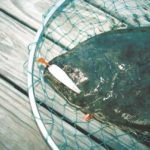
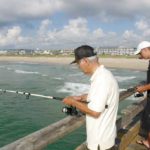
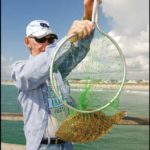
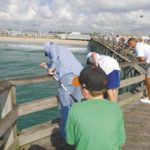
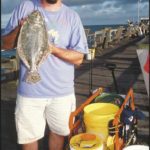



Be the first to comment